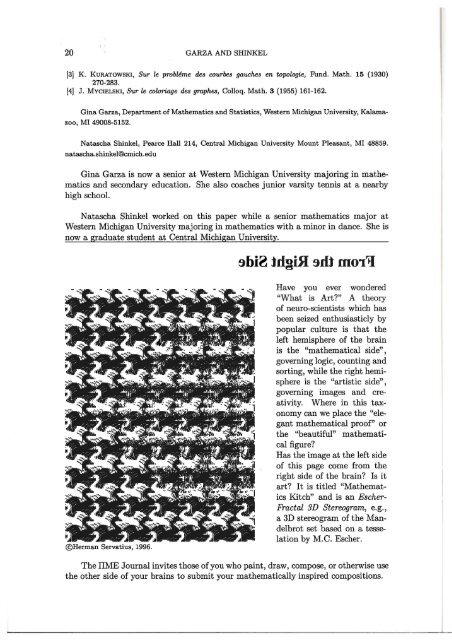Create successful ePaper yourself
Turn your PDF publications into a flip-book with our unique Google optimized e-Paper software.
20 GARZA AND SHINKEL<br />
TIME Journal, <strong>Vol</strong>. <strong>11</strong>, <strong>No</strong>. 1, pp 21- 22, 1999. 21<br />
[3] K. KURATOWSKI, Sur le probleme des courbes gauches en topologie, Fund. Math. 15 (1930)<br />
270-283.<br />
[4] J. MYCIELSKI, Sur le coloriage des graphes, Colloq. Math. 3 (1955) 161-162.<br />
Gina Garza, Department of Mathematics and Statistics, Western Michigan University, Kalamazoo,<br />
MI 49008-5152.<br />
Natascha Shinkel, Pearce Hall 214, Central Michigan University Mount Pleasant, MI 48859.<br />
natascha.shinkel@cmich.edu<br />
Gina Garza is now a senior at Western Michigan University majoring in mathematics<br />
and secondary education. She also coaches junior varsity tennis at a nearby<br />
high school.<br />
N atascha Shinkel worked on this paper while a senior mathematics major at<br />
Western Michigan University majoring in mathematics with a minor in dance. She is<br />
now a graduate student at Central Michigan University.<br />
@Herman Servatius, 1996.<br />
Have you ever wondered<br />
"What is Art?" A theory<br />
of neuro-scientists which has<br />
been seized enthusiasticly by<br />
popular culture is that the<br />
left hemisphere of the brain<br />
is the "mathematical side" ,<br />
governing logic, counting and<br />
sorting, while the right hemisphere<br />
is the "artistic side" ,<br />
governing images and creativity.<br />
Where in this taxonomy<br />
can we place the "elegant<br />
mathematical proof" or<br />
the "beautiful" mathematical<br />
figure?<br />
Has the image at the left side<br />
of this page come from the<br />
right side of the brain? Is it<br />
art? It is titled "Mathematics<br />
Kitch" and is an Escher<br />
Fractal 3D Stereogram, e.g. ,<br />
a 3D stereogram of the Mandelbrot<br />
set based on a tesselation<br />
by M.C. Escher.<br />
The liME Journal invites those of you who paint, draw, compose, or otherwise use<br />
the other side of your brains to submit your mathematically inspired compositions.<br />
WHEN ARE AN - 1 AND AM- 1 AMICABLE?<br />
FLORIAN LUCA*<br />
For any positive integer k let a(k) be the divisor sum of k. Two positive integers<br />
s and t are called amicable if a(s) = a(t) = s + t. A positive integer s which is<br />
self-amicable is called perfect.<br />
In [3], we showed that no Fibonacci or Lucas number is perfect. In [4], we showed<br />
that no Fermat number, i.e. a number of the form 2 2 n + 1 for some integer n 2: 0,<br />
can be either perfect or part of an amicable pair.<br />
Let a> 1 be a positive integer. In this note, we prove the following:<br />
THEOREM 1. If am- 1 and an- 1 are amicable, then m = n = 1 and a- 1 is<br />
perfect.<br />
Let us remark first that:<br />
LEMMA 2. If s > 1 is a positive integer, then a(s) ::; 3s 2 /4.<br />
Proof Since a(st) ::; a(s)a(t) for any two positive integers s and t, it suffices to<br />
check the asserted inequality only when s is prime. But if s is prime, then a(s) =<br />
s + 1 ::; 3s 2 /4 with equality if and only if s = 2. D<br />
Proof of the Theorem. Since the involved expressions are symmetric in m and n ,<br />
we shall always assume that m ::; n.<br />
Assume first that m = 1. We need to show that n = 1.<br />
Assume that n > 1. Suppose first that a= 2. Since an -1 = 2n -1 and a - 1 = 1<br />
are amicable, we get a(2n - 1) = a(l) = a(l) = 1 which forces 2n - 1 = 1, hence<br />
n = 1.<br />
Suppose now that a> 2. Since an-1 and a-1 are amicable, we get a(a- 1) = an+<br />
a-2. Since by the Lemma, a(a - 1)::; i(a - 1)2 , it follows that an+a - 2::; i(a - 1) 2 •<br />
Since n 2: 2, we get a 2 +a- 2 ~ i(a -1) 2 , which is equivalent to a 2 +lOa::; ll,which<br />
is certainly impossible for a> 2.<br />
From now on, we assume n > 1. Suppose first that n = m. In this case, an - 1<br />
is perfect. It follows easily that a is odd. Indeed, if a is even, then an - 1 is an<br />
odd perfect number which is congruent to -1 modulo 4. On the other hand, it is<br />
well-known that if an odd perfect number exists, then it should be of the form px 2<br />
for some prime p = 1 (mod 4). Hence, a is odd. In this case, an - 1 is an even perfect<br />
number, therefore an - 1 = 2P-l (2P- 1), where 2P- 1 is a Fermat prime. Write<br />
Since<br />
an - 1 a 2 - 1<br />
--- > -- = a+l >a-1,<br />
a-1 - a-1<br />
it follows easily that the prime 2P -1 divides (an -1)/(a-1). Hence (an -1)/(a-1) =<br />
2u(2P - l)and a - 1 = 2v where u+v = p-1. When n is odd, the number (an-1)/(a- 1)<br />
is odd as well, hence u = 0. It follows that a= 2P-l + 1, and<br />
an -1 a 3 - 1<br />
2P- 1 = -- 2: --= a 2 +a+ 1 = (2P-l + 1) 2 + (2p-l + 1) + 1,<br />
a - 1 a - 1<br />
*Mathematical Institute, Czech Academy of Sciences
















